
From Good to Great: How to Create Beats That Truly Stand Out
Creating beats that captivate listeners is both an art and a science. Whether you’re an aspiring producer looking to break into the music scene or a seasoned veteran aiming to refine your craft, the pursuit of better beats is a never-ending journey. Beats are the foundation of many musical genres, from hip-hop and electronic music to pop and beyond. They set the mood, drive the energy, and often define the very essence of a track. However, making beats that stand out in a crowded music landscape requires more than just a basic understanding of rhythm and sound. It involves mastering the tools at your disposal, experimenting with different techniques, and, most importantly, infusing your unique creativity into every beat you craft.
In this comprehensive guide, “Ultimate Guide: How to Make Better Beats,” we’ll explore the key elements that can transform your beat-making process. We’ll cover everything from the technical aspects of using digital audio workstations (DAWs) and understanding sound design, to the more nuanced skills of layering, sampling, and mixing. But we won’t stop there. This guide also dives into the creative mindset needed to consistently produce fresh, innovative beats that grab attention and keep listeners coming back for more.
Whether you’re struggling to overcome creative blocks, looking to add more complexity and depth to your beats, or simply seeking new inspiration, the tips outlined here will help you take your production skills to the next level. By the end of this guide, you’ll not only understand how to make better beats—you’ll be equipped to create tracks that are memorable, impactful, and uniquely yours. So, let’s get started on this journey to unlocking the full potential of your beat-making abilities and making music that truly resonates.
It’s All About Capturing Emotion
At the core of every great beat is the ability to evoke emotion. Music has a unique power to make people feel something, and your beats should aim to harness that power. Whether you’re producing a high-energy track meant to get people moving or a more laid-back vibe that encourages introspection, the emotional impact of your beats is what will make them memorable.
Capturing emotion in your beats begins with understanding the mood you want to convey. Think about the story you want your music to tell. Are you trying to create tension, excitement, sadness, or joy? Once you’ve identified the emotion, you can start to shape your beat around it. This might involve selecting specific instruments or samples that align with the mood or manipulating rhythm and tempo to reflect the emotional tone you’re aiming for.
Another key aspect of capturing emotion is the use of dynamics. Variations in volume, intensity, and pacing can significantly influence how a listener experiences your beat. A well-placed drop or a sudden shift in rhythm can evoke surprise, while a steady build-up can create anticipation. These dynamic changes keep your beat engaging and help reinforce the emotional journey you’re crafting.
Remember, music is a form of expression, and your beats are an extension of that. Don’t be afraid to experiment and push boundaries to create something that truly resonates. Whether you’re drawing from personal experiences or tapping into a broader emotional landscape, the goal is to make your listeners feel connected to the music on a deeper level. By focusing on emotion, your beats can transcend mere sounds and become powerful tools for storytelling and expression.
A Good Beat Means You Are Expressing Yourself
A truly great beat is more than just a collection of sounds and rhythms—it’s a reflection of who you are as an artist. When you create a beat, you’re not just piecing together patterns; you’re sharing a part of yourself with the world. Your influences, your emotions, your thoughts, and your experiences all come through in the music you produce. This personal touch is what makes a beat stand out and resonate with listeners.
Expressing yourself through your beats starts with being authentic. Don’t feel pressured to mimic what’s trending or to sound like someone else. Instead, focus on what excites you, what moves you, and what you want to say through your music. This might mean breaking the rules, experimenting with unconventional sounds, or blending genres in a way that’s uniquely yours. The most memorable beats often come from producers who aren’t afraid to be different and who let their individuality shine through.
Another important aspect of self-expression in beat-making is your creative process. How you approach creating a beat—whether it’s starting with a melody, building around a drum pattern, or layering sounds organically—should feel natural to you. Your workflow is a part of your identity as a producer, and embracing it allows you to create music that is genuinely reflective of your style and vision.
In essence, when you’re making a beat, you’re telling a story—your story. Each beat is an opportunity to communicate something personal, whether it’s a mood, a memory, or an idea. The more you infuse your personality and experiences into your music, the more powerful and authentic your beats will be. And when listeners can hear and feel that authenticity, they’re more likely to connect with your music on a deeper level. So, don’t just make beats; use them as a canvas to express who you are and what you stand for as an artist.
Don’t Use Shortcuts By Only Using Samples
While samples can be an excellent tool in beat-making, relying solely on them can limit your creativity and stunt your growth as a producer. Samples are often pre-packaged pieces of someone else’s work, and while they can provide a solid foundation, they shouldn’t be the entirety of your beat. If you’re serious about making better beats, it’s crucial to go beyond simply dragging and dropping samples into your DAW.
Relying heavily on samples can make your beats sound generic or overly similar to others. This is because many producers use the same popular samples, leading to a saturation of similar-sounding tracks. To avoid this, challenge yourself to use samples as a starting point rather than the end product. Manipulate them, chop them up, and layer them with your original sounds to create something unique. The key is to make the sample your own, so it contributes to your artistic voice rather than overshadowing it.
Moreover, focusing too much on samples can prevent you from developing essential skills in sound design, synthesis, and composition. These skills are crucial for creating original sounds that can set your beats apart from the rest. Experimenting with different instruments, synths, and sound design techniques can lead to the discovery of new textures and rhythms that you wouldn’t find in pre-made samples.
Using samples should be about enhancing your creativity, not limiting it. They can serve as inspiration or a foundation upon which you build, but the real magic happens when you add your personal touch. Whether it’s layering your own drums over a sampled groove, creating a new melody that complements a sample, or altering the sample to fit your vision, the goal is to push your creative boundaries.
In the end, samples are just one tool in your beat-making arsenal. Don’t let them become a crutch. By learning to incorporate them thoughtfully and combining them with your original ideas, you’ll be able to create beats that are not only unique but also a true reflection of your artistic identity.
Technology Is Here to Help, Not to Do the Work for You
In today’s digital age, the tools available to music producers are more powerful and accessible than ever before. From advanced digital audio workstations (DAWs) to a vast array of plugins, virtual instruments, and effects, the possibilities for creating music are virtually endless. However, while technology can significantly enhance your production capabilities, it’s important to remember that it’s meant to assist you—not replace your creativity and effort.
Technology can streamline your workflow, providing shortcuts for tasks that would otherwise take hours to complete. For example, automation can handle repetitive processes and presets can give you a quick starting point for sound design. However, relying too heavily on these features can lead to a lack of originality in your music. Presets, loops, and automatic composition tools are great for inspiration, but if you lean on them too much, your beats can start to sound formulaic and uninspired.
True artistry comes from making deliberate choices and crafting your sound. While it’s easy to let a plugin generate a chord progression or to use a pre-made drum loop, the real value lies in your ability to manipulate, modify, and shape those elements into something unique. Use technology to speed up the technical side of production, but always take the time to inject your personal touch into the process.
Moreover, learning the ins and outs of your tools will empower you to push them to their limits and create something truly original. Instead of just scrolling through presets, dive deeper into sound design—tweak the parameters, experiment with different effects chains, and combine elements in unexpected ways. This not only sets your beats apart but also helps you grow as a producer.
In short, while technology offers incredible tools that can enhance your music production, it should never be a substitute for creativity and hard work. Use it to amplify your ideas, not to generate them. By keeping technology in its rightful place—as a powerful assistant rather than the driver—you’ll be able to create beats that are not only technically impressive but also rich with your unique artistic expression.
Conclusion
Mastering the art of beat-making is a journey that blends creativity, technical skill, and personal expression. As you refine your craft, remember that the most impactful beats are those that resonate emotionally, reflect your unique artistic voice, and go beyond the confines of pre-made samples and automated tools. While technology can greatly enhance your production process, it’s your creativity, effort, and willingness to experiment that will set your beats apart.
By focusing on capturing emotion, expressing yourself authentically, avoiding shortcuts, and using technology as an aid rather than a crutch, you can elevate your beat-making to new heights. Each beat you create is an opportunity to tell a story, share a piece of yourself, and connect with listeners on a deeper level. So, embrace the process, push your boundaries, and let your passion for music shine through in every beat you make.
In the end, the best beats aren’t just heard—they’re felt. They move people, spark inspiration, and leave a lasting impression. With the tips and insights shared in this guide, you’re well on your way to creating beats that do just that. Keep experimenting, keep creating, and most importantly, keep making beats that truly resonate.
Browse Beats & Instrumentals
Check out my extensive catalog of more than 500 custom-made beats and instrumentals, available for free download or licensing.


No Comments